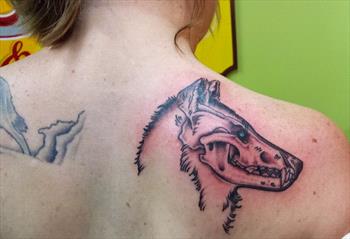Carla tattoo

Photo courtesy of Dr. Carla Burris
I am a giant needle weenie.
I've got three tattoos and I was fine while getting all of them. Those were hour-long backrubs to be honest. Now you bring out a vaccination needle or (OMG!) want to put in an IV catheter, I get extra pale. And local anesthesia for getting a cavity filled? Let's just say it's a good thing those dental chairs recline.
You may laugh (and many have) at the irony of a tattooed veterinarian with pierced ears blanching at the thought of having blood drawn, but everyone (including me) that's been on the other end of the needle has dealt with many needle weenies. It's often no big deal when properly managed. However, contrary to some opinions, “suck it up, buttercup” does not count as properly managed.
How do I cope? Preparation, honesty, and humor. Those three things have allowed me to get necessary dental work, give blood, and get my COVID vaccine. I'll never like needles that are aimed at me, but I can deal. So how do those work in practice?
Honesty is the most important. I warn my healthcare providers that I am a needle weenie. It's not a huge conversation, just a warning that I'm a needle weenie (but not a flincher!) and if I should happen to keel over, they should just carry on with the procedure. (Because who wants to be roused from a faint just to have to face the same needle again?) The response is always a knowing nod, some sort of comforting statement, and no judgment.
Preparation starts with dressing appropriately for the procedure: comfortable clothing that doesn't involve stripping or require two extra hands to hold up a sleeve. Then I find a way to sit that braces me upright (or at least minimizes the odds of cracking my skull should I swoon gently off my chair), present the requisite body part, look away, and go to my happy place. When the harpooning is over, I sit up s-l-o-w-l-y and pause a few seconds to make sure that my blood supply came with me before standing.
Humor is the secret sauce that makes the honesty and preparation work. I never get tired of informing someone of my needle weenieness while rolling up my sleeve to display the edge of a tattoo – some of the looks are priceless. Laughing releases endorphins and decreases stress. And needles always work better when there's less stress in the room.
Trypanophobia, the technical term for needle aversion, isn't seen just in human medicine – it's quite common in veterinary clinics too. Many veterinarians have seen the burliest guys go chalk white when the heartworm test blood is drawn. Or the new pet owner that clutches her puppy tighter with every mention of vaccines or microchip needles. And sometimes it's the pet that can't stand needles, demonstrating a Jekyll-and-Hyde reaction to the jab.
The same honesty, preparation, and humor work in vet med too. If you or your pet are a needle weenie, here's what you can do:
- Admit there's a problem before the needles come out. Too many veterinarians have seen a pet owner drop to the floor without warning or a dog that's totally chill for their exam turns into a screaming cyclone of teeth when a needle goes in. These are surprises that no one wants. Tell the veterinarian or technician beforehand so they can help mitigate the problem. Sometimes it's as simple as warning you before the syringe is uncapped so you can look away.
- Ask to have your pet taken “to the back” for any procedures. A very large number of pets that freak out in the presence of their owner do just fine when separated from the owner. Animals are quite sensitive to the body language and stress responses of their people – if you're having a mental meltdown, Buster's picking up on it and stressing out too. Obviously, if you never see the needle, you won't faint at the sight of it going in.
- Make veterinary visits fun. Break out the treats and distractions. If a veterinary visit is 99% ear rubs and happy voices and peanut butter and 1% sharp pokey bits, most pets barely notice needles. Ask your veterinarian if you can bring your dog for ‘happy visits' or how to carrier train your cat.
- Consider pre-visit sedatives (for your pet, not you, especially if you're driving). If your pet has already developed a solid case of hospital anxiety, sometimes they just need a little something to take the edge off. Ask your veterinarian if they'll prescribe a low dose of a sedative for you to give the night before and/or morning of their next checkup.
- Don't stress. Aversion to needles (or blood or surgery or whatever) isn't a personal failing or character flaw in you or your pet. It's common and not at all a big deal if addressed early and honestly. Find a way to laugh about it if you can – humor takes the tension level down for everybody and opens up space to talk about creative ways to address the problem.
- Whatever you do, DON'T PUNISH. Yelling at them, holding them down as they struggle, or swatting them afterwards does nothing other than cement in their mind that this is a very bad no good situation. Next time will be even worse for everyone. Repeat often enough and you get a pet that screams as soon as you pull into the parking lot. If you or your pet are starting to get worked up, everyone should pause, take a deep breath, and find a different approach.
While my needle weenieness isn't severe – I don't have full-blown panic attacks – it is something that I have to cope with from time to time. Maybe next time I get a flu shot I should bring peanut butter on a tongue depressor to distract myself.